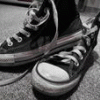Natürlich ist Akne u.a. genetisch und hormonell bedingt!
Aber u.a. auf der hormonellen Ebene setzt ja eine spezielle
und oft gesündere Anti-Akne Ernährung an!(siehe Studie)
Auch die Beeinflussung/Senkung des Insulin-Wertes spielt
hier eine Rolle.
Und wer nicht wenigstens 3 Monate konsequent eine
spezielle Anti-Akne Ernährung durchgezogen hat
wird es schwer haben den Aspekt der Ernährung in Bezug zu seiner
Akne richtig einschätzen zu können. Was natürlich nicht heisst
das es die Akne komplett beseitigen wird, die Erfolge oder auch Misserfolge
werden wohl bei jedem unterschiedlich sein.
-------------------------------------------------------------------------
Mol Nutr Food Res. 2008 Jun;52(6):718-26.
A pilot study to determine the short-term effects of a low glycemic load diet on hormonal markers of acne: a nonrandomized, parallel, controlled feeding trial.
Smith R, Mann N, Mäkeläinen H, Roper J, Braue A, Varigos G.
School of Applied Sciences, RMIT University, Melbourne, Australia.
robyn.smith@rmit.edu.auObservational evidence suggests that dietary glycemic load may be one environmental factor contributing to the variation in acne prevalence worldwide. To investigate the effect of a low glycemic load (LGL) diet on endocrine aspects of acne vulgaris, 12 male acne sufferers (17.0 +/- 0.4 years) completed a parallel, controlled feeding trial involving a 7-day admission to a housing facility. Subjects consumed either an LGL diet (n = 7; 25% energy from protein and 45% from carbohydrates) or a high glycemic load (HGL) diet (n = 5; 15% energy from protein, 55% energy from carbohydrate). Study outcomes included changes in the homeostasis model assessment of insulin resistance (HOMA-IR), sex hormone binding globulin (SHBG), free androgen index (FAI), insulin-like growth factor-I (IGF-I), and its binding proteins (IGFBP-I and IGFBP-3). Changes in HOMA-IR were significantly different between groups at day 7 (-0.57 for LGL vs. 0.14 for HGL, p = 0.03). SHBG levels decreased significantly from baseline in the HGL group (p = 0.03), while IGFBP-I and IGFBP-3 significantly increased (p = 0.03 and 0.03, respectively) in the LGL group. These results suggest that increases in dietary glycemic load may augment the biological activity of sex hormones and IGF-I, suggesting that these diets may aggravate potential factors involved in acne development.
--------------------------------------------------------------------------
Und was die Milch für ein Hormongemisch darstellt kann man hier nachlesen:
http://www.acnehelp..../Commentary.pdfDadurch kommen dann solche Studien zustande:
J Am Acad Dermatol. 2008 May;58(5):787-93. Epub 2008 Jan 14.
Milk consumption and acne in teenaged boys.
Adebamowo CA, Spiegelman D, Berkey CS, Danby FW, Rockett HH, Colditz GA, Willett WC, Holmes MD.
Department of Nutrition, Harvard School of Public Health, Boston, Massachusetts, USA.
OBJECTIVE: We sought to examine the association between dietary dairy intake and teenaged acne among boys. METHODS: This was a prospective cohort study. We studied 4273 boys, members of a prospective cohort study of youths and of lifestyle factors, who reported dietary intake on up to 3 food frequency questionnaires from 1996 to 1998 and teenaged acne in 1999. We computed multivariate prevalence ratios and 95% confidence intervals for acne. RESULTS: After adjusting for age at baseline, height, and energy intake, the multivariate prevalence ratios (95% confidence interval; P value for test of trend) for acne comparing highest (>2 servings/d) with lowest (<1/wk) intake categories in 1996 were 1.16 (1.01, 1.34; 0.77) for total milk, 1.10 (0.94, 1.28; 0.83) for whole/2% milk, 1.17 (0.99, 1.39; 0.08) for low-fat (1%) milk, and 1.19 (1.01, 1.40; 0.02) for skim milk. LIMITATIONS: Not all members of the cohort responded to the questionnaire. Acne assessment was by self-report and boys whose symptoms might have been part of an underlying disorder were not excluded. We did not adjust for steroid use and other lifestyle factors that may affect occurrence of acne. CONCLUSION: We found a positive association between intake of skim milk and acne. This finding suggests that skim milk contains hormonal constituents, or factors that influence endogenous hormones, in sufficient quantities to have biological effects in consumers.
Dermatol Online J. 2006 May 30;12(4):1.Links
Milk consumption and acne in adolescent girls.
Adebamowo CA, Spiegelman D, Berkey CS, Danby FW, Rockett HH, Colditz GA, Willett WC, Holmes MD.
Department of Nutrition, Harvard School of Public Health, Boston, USA.
There has been a remarkable paucity of evidence for an association between diet and acne. Our previous studies suggest that there is an association between milk intake and teenage acne. This is a prospective cohort study to evaluate that relationship. We studied 6,094 girls, aged 9-15 years in 1996, who reported dietary intake on up to three food frequency questionnaires from 1996 to 1998. Presence and severity of acne was assessed by questionnaire in 1999. We computed multivariate prevalence ratios (PR) and 95 percent confidence intervals for acne. After accounting for age at baseline, height and energy intake, the multivariate PRs (95 % CI; p-value for test of trend) for acne comparing highest (2 or more servings per day) to lowest (<1 per week) intake categories in 1996, were 1.20 (1.09, 1.31; <0.001) for total milk, 1.19 (1.06, 1.32; <0.001) for whole milk, 1.17 (1.04, 1.31; 0.002) for low fat milk and 1.19 (1.08, 1.31; <0.001) for skim milk. This result did not change appreciably when we excluded girls who reported use of contraceptives and when we restricted our analysis to those younger than 11 years of age at baseline. We found a positive association between intake of milk and acne. This finding supports earlier studies and suggests that the metabolic effects of milk are sufficient to elicit biological responses in consumers.
J Am Acad Dermatol. 2005 Feb;52(2):207-14.
High school dietary dairy intake and teenage acne.
Adebamowo CA, Spiegelman D, Danby FW, Frazier AL, Willett WC, Holmes MD.
Department of Nutrition, Harvard School of Public Health, Boston, Massachusetts 02115, USA.
clement.adebamowo@channing.harvard.edu[/email]
BACKGROUND: Previous studies suggest possible associations between Western diet and acne. We examined data from the Nurses Health Study II to retrospectively evaluate whether intakes of dairy foods during high school were associated with physician-diagnosed severe teenage acne. METHODS: We studied 47,355 women who completed questionnaires on high school diet in 1998 and physician-diagnosed severe teenage acne in 1989. We estimated the prevalence ratios and 95% confidence intervals of acne history across categories of intakes. RESULTS: After accounting for age, age at menarche, body mass index, and energy intake, the multivariate prevalence ratio (95% confidence intervals; P value for test of trend) of acne, comparing extreme categories of intake, were: 1.22 (1.03, 1.44; .002) for total milk; 1.12 (1.00, 1.25; .56) for whole milk; 1.16 (1.01, 1.34; .25) for low-fat milk; and 1.44 (1.21, 1.72; .003) for skim milk. Instant breakfast drink, sherbet, cottage cheese, and cream cheese were also positively associated with acne. CONCLUSION: We found a positive association with acne for intake of total milk and skim milk. We hypothesize that the association with milk may be because of the presence of hormones and bioactive molecules in milk.
Bearbeitet von pm2, 02 October 2008 - 14:37 Uhr.












